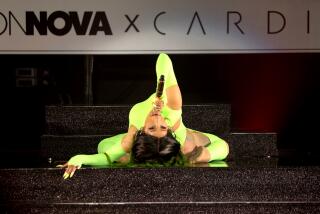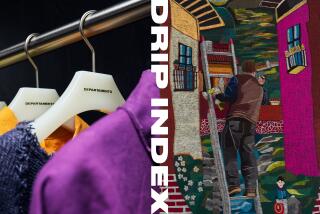Bijan property on Rodeo Drive sells for $19,000 a square foot
The demand for $5,000 handbags and $25,000 suits is slipping amid global turmoil.
But enthusiasm for real estate on Rodeo Drive, where such high-end goods are sold, isnât hurting. Instead itâs setting records.
The parent company of Louis Vuitton recently paid $122 million, or $19,405 a square foot, for the yellow House of Bijan building at 420 N. Rodeo, long home to a boutique known as âthe most expensive store in the world.â The deal, revealed in public records, was the second time in seven months that a record fell on Rodeo.
Late last year, Chanel paid $13,217 a square foot for a store it was leasing nearby at 400 N. Rodeo, the high-water mark for California retail until last monthâs Bijan sale.
The eye-popping amounts reflect how few properties there are on the Beverly Hills street, as well as how infrequently they go on sale. And in a struggling market for luxury goods, the deals underscore that high-profile streets such as Rodeo or Manhattanâs upper Fifth Avenue are far more than a place to sell a $10,000 timepiece.
âThey are billboards in some places for the brand,â said Milton Pedraza, chief executive of consulting firm Luxury Institute. âThe companies can demonstrate power, and their staying power, by buying up these properties.â
Indeed, Marc Schillinger, a director with commercial real estate company HFF who represented the seller Bijan Properties, said âeveryone came out of the woodwork when we announced the opportunity to buy this asset.â
âThere are only 2½ blocks on Rodeo Drive,â said Schillinger, who declined to confirm the price or buyer. uEvery luxury retailer wants to anchor their brand on Rodeo.â
Thatâs proving true even as the luxury retail market takes a breather. Sales of luxury goods in the U.S. have fallen around 10% on average over the last year, while traffic in luxury stores is down 20%, Pedraza said.
The downbeat numbers are due to several reasons -- similar to ones that have softened ultra-high-end residential real estate markets in places such as Los Angeles, New York and London.
Slowing global economies and a strong U.S. dollar have sapped the buying power of foreigners and dampened tourism. Meanwhile, uncertainty over the economy in the U.S., along with the upcoming presidential election, has caused some wealthy Americans to hit pause on big purchases.
On Friday, Italian retailer Prada said its retail sales in the Americas fell 15% in the first half of the year, explaining that the U.S. market âremains tough.â
âSo many factors have converged -- unfortunately in a negative way,â Pedraza said.
LVMH MoĂŤt Hennessy Louis Vuitton has done better than many retailers though. The Paris-based luxury goods conglomerate reported that U.S. sales climbed 7% during the first half of the year.
A high-profile store, however, isnât just about selling goods. Even in the age of e-commerce, high-end digs have worth as a place to hold flashy events and market a brandâs cachet across the globe.
Fashion houses are willing to pay a premium to buy such an opportunity. Theyâd rather do so than rent and risk losing the location if their lease is not renewed, said Robert Cohen, vice chairman of real estate firm RKF.
Thatâs especially true as fast-fashion companies with far lower prices increasingly compete for such locations, including an H&M that opened on a pricey stretch of Fifth Avenue in Manhattan in 2014.
The highest price per square foot for a U.S. retail space came two years ago when Chanel purchased a shop it was leasing in New York on Madison Avenue for $31,329 a square foot, according to Real Capital Analytics.
âThey are protecting their position on the street and in the market,â Cohen said of such purchases.
Itâs unclear what LVMHâs plans are for the Bijan building, where the iconic store has operated for 40 years.
The Paris retailer with 70 brands already has multiple stores on Rodeo including Louis Vuitton and Dior locations that it leases and a Celine store that it owns.
A spokesperson for LVMH declined to comment, as did a manager at Bijan.
Iranian American designer Bijan Pakzad opened his appointment-only boutique on Rodeo Drive in 1976. It became known for its ultra luxury goods such as $6,000 suits and $19,000 ostrich vests.
Through the years, House of Bijan counted many high-profile names among his clients, including Michael Eisner, King Juan Carlos of Spain and Presidents Carter, George H.W. Bush, Clinton, George W. Bush and Obama. Pakzad had success to match, with homes across the world he flew to on his own jet.
Pakzad died in 2011 but left a lasting imprint on Rodeo Drive, helping to make it a world-class destination. The storeâs manager, who declined to give his name, said the store is now owned by Pakzadâs family.
âLong before Tom Ford and Karl Lagerfeld, Bijan had a keen understanding of the cult of personality in fashion, starring in his own ads and billboards, name-checking countless celebrities and parking exotic cars outside his store, all to stoke his fame,â former Times fashion critic Booth Moore said following Pakzadâs death.
But throughout the decades, as rents soared along with the cachet, Rodeo has lost many of its local boutiques, including Fred Haymanâs famed Giorgio Beverly Hills, with its distinctive white-and-yellow striped awning, which closed in 1998.
The Bijan store is operating under a lease; its expiration has not been disclosed.
Given the sky-high sale to LVMH, the pricey but small House of Bijan is likely to go as well, real estate broker Cohen said.
The French firm may want to bring in a deep-pocketed tenant who would pay more in rent, or give yet another of its brands a foothold on Rodeo.
âItâs one of the greatest luxury streets in the world,â he said. âItâs global branding and global domination.â
Follow me @khouriandrew on Twitter
MORE BUSINESS NEWS
Will Hyundaiâs eco-friendly Ioniq woo hearts away from Prius?
How to calculate the âmagic numberâ for college savings
Drug companies spend millions to keep charging high prices
UPDATES:
4:30 p.m. This article has been updated throughout with additional details and comments.
The article was first publised at 7:30 p.m. Thursday
More to Read
Inside the business of entertainment
The Wide Shot brings you news, analysis and insights on everything from streaming wars to production â and what it all means for the future.
You may occasionally receive promotional content from the Los Angeles Times.










